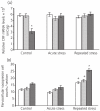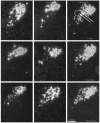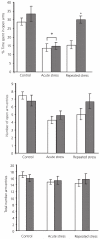17Beta-oestradiol modulates glucocorticoid, neural and behavioural adaptations to repeated restraint stress in female rats
- PMID: 15344916
- PMCID: PMC2651633
- DOI: 10.1111/j.1365-2826.2004.01234.x
17Beta-oestradiol modulates glucocorticoid, neural and behavioural adaptations to repeated restraint stress in female rats
Abstract
Sex steroids have a role in modulating responses that extends beyond reproduction. The current study investigated the influence of the sex steroid 17beta-oestradiol on hypothalamic-pituitary-adrenal (HPA) and behavioural responses to acute or repeated restraint stress. Ovariectomized rats treated with 17beta-oestradiol or peanut oil via a subcutaneous silastic capsule were subjected to daily handling (non stressed), acute (single, 1 h) or daily (10 days, 1 h/day) restraint stress. Blood collected at the end of stress revealed that 17beta-oestradiol treatment augmented the corticosterone response to acute restraint. After daily exposure to restraint, the corticosterone response was noticeably diminished in untreated females but 17beta-oestradiol-treated rats still showed an exaggerated response compared to castrated, untreated females. Brain tissue collected 3 h after the end of restraint was probed using isotopic in situ hybridization for corticotropin-releasing factor (CRF) and vasopressin gene expression in the paraventricular nucleus (PVN) of the hypothalamus. 17beta-oestradiol treatment at the higher dose (120 microg/ml) decreased basal CRF mRNA. Stress caused an increase in CRF mRNA expression in 17beta-oestradiol-treated rats but not in the vehicle group. Repeated restraint stress caused an increase in PVN parvocellular vasopressin gene expression, which was more pronounced in 17beta-oestradiol-replaced rats. Animals were exposed to the elevated plus maze for 5 min as a test for anxiety. Non-stressed control rats with or without 17beta-oestradiol replacement spent the same percentage amount of time exploring the open arms of the maze. Previous exposure to acute restraint stress caused a marked reduction in the time spent exploring the open arms, indicating an increase in anxiety levels in these rats; this effect was observed in both vehicle and 17beta-oestradiol-treated rats. After repeated restraint stress, 17beta-oestradiol-replaced rats spent as much time exploring the open arms of the maze as controls, indicating adaptation. By contrast, nonreplaced rats were still showing a significant reduction in open arm exploration after repeated restraint. The present study presents novel data showing that the HPA axis remains reactive to repeated stress in 17beta-oestradiol-treated ovariectomized rats, but stress-induced anxiety behaviour is reduced.
Figures

 , 120 μg/ml 17β-oestradiol *Significantly different from corresponding vehicle group; +significantly different from control group (P < 0.05, Bonferroni).
, 120 μg/ml 17β-oestradiol *Significantly different from corresponding vehicle group; +significantly different from control group (P < 0.05, Bonferroni).
 , 40 μg/ml 17β-oestradiol; ■, 120 μg/ml 17β-oestradiol. (
, 40 μg/ml 17β-oestradiol; ■, 120 μg/ml 17β-oestradiol. (


 , 120 μg/ml 17β-oestradiol. +Significantly different from vehicle control; *significantly different from vehicle repeated restraint group (P < 0.05, Bonferroni).
, 120 μg/ml 17β-oestradiol. +Significantly different from vehicle control; *significantly different from vehicle repeated restraint group (P < 0.05, Bonferroni).References
-
- Lesniewska B, Nowak M, Malendowicz LK. Sex differences in adrenocortical structure and function. XXVIII. ACTH and corticosterone in intact, gonadectomised and gonadal hormone replaced rats. Horm Metab Res. 1990;22:378–381. - PubMed
-
- Lesniewska B, Miskowiak B, Nowak M, Malendowicz LK. Sex differences in adrenocortical structure and function. XXVII. The effect of ether stress on ACTH and corticosterone in intact, gonadectomized, and testosterone- or estradiol-replaced rats. Res Exp Med (Berl) 1990;190:95–103. - PubMed
-
- Weinstock M, Razin M, Schorer-Apelbaum D, Men D, McCarty R. Gender differences in sympathoadrenal activity in rats at rest and in response to footshock stress. Int J Dev Neurosci. 1998;16:289–295. - PubMed
-
- Johnston AL, File SE. Sex differences in animal tests of anxiety. Physiol Behav. 1991;49:245–250. - PubMed
-
- Steenbergen HL, Heinsbroek RP, Van Hest A, Van de Poll NE. Sex-dependent effects of inescapable shock administration on shuttlebox-escape performance and elevated plus-maze behavior. Physiol Behav. 1990;48:571–576. - PubMed

